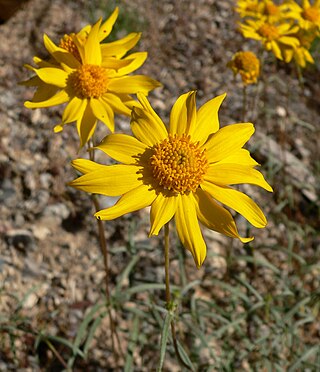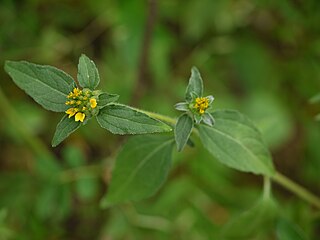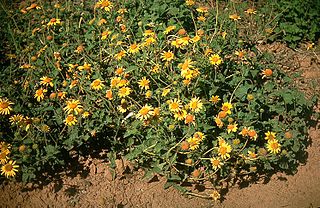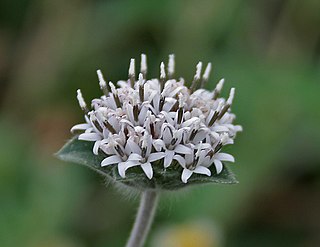
The Heliantheae are the third-largest tribe in the sunflower family (Asteraceae). With some 190 genera and nearly 2500 recognized species, only the tribes Senecioneae and Astereae are larger. The name is derived from the genus Helianthus, which is Greek for sun flower. Most genera and species are found in North America and South America. A few genera are pantropical.

Thymophylla is a genus of perennial flowering plants in the tribe Tageteae within the family Asteraceae. Pricklyleaf is a common name for plants in this genus.
Pappobolus is a genus of flowering plant in the family Asteraceae native to the Andes Mountains of Colombia, Ecuador, and Peru.

Viguiera is a genus of flowering plants in the family Asteraceae. It contains around 19–40 species, which are commonly known as goldeneyes and are native to the New World. These are herbs to bushy shrubs that bear yellow or orange daisy-like flowers.

Tithonia is a genus of flowering plants in the tribe Heliantheae within the family Asteraceae.

Heliomeris is a genus of flowering plants in the family Asteraceae, known generally as false goldeneyes.

Aldama is a genus of flowering plants in the family Asteraceae. The native range of this genus is tropical & sub-tropical America. The genus was originally described to include one species of subtribe Helianthinae that were characterized by having pales that tightly enclosed the cypselae (achenes).

Hymenostephium is a genus of flowering plants in the family Asteraceae. It includes herbs and slender shrubs that occur from Mexico through to Venezuela and north-western Argentina.

Sclerocarpus is a genus of flowering plants in the tribe Heliantheae within the family Asteraceae. Bonebract is a common name for plants in this genus.

Simsia is a genus of flowering plants in the tribe Heliantheae within the family Asteraceae. It includes annuals, herbaceous perennials, and shrubs. They range from the western United States south through Central and South America to Argentina, with the center of diversity occurring in Mexico. The genus is named for British physician and botanist John Sims (1749–1831). Although some species are relatively rare, others have become common weeds that line the roadsides and fields of Mexico, often forming dense stands mixed with Tithonia and other Asteraceae. Some species are known by the common name bushsunflower.

Lagascea is a genus of flowering plants in the family Asteraceae. It occurs primarily in Mexico, but some species extend into Central America and one reaches north into the western United States. One species, L. mollis, has been widely introduced to other localities around the tropics and subtropics.
Otopappus is a genus of flowering plants in the tribe Heliantheae within the family Asteraceae, primarily Mesoamerican but with one species from Jamaica.
Rhysolepis was a genus of Mexican plants in the tribe Heliantheae within the family Asteraceae. Until 2011, when botanists Schilling & Panero studied the subtribe Helianthinae based on molecular sequences of nuclear ITS, ETS, and cpDNA, coming to a conclusion that that the genus ViguieraKunth, did not constitute a monophyletic group. Among their conclusions they proposed to reclassify the genus, dividing and relocating its species in at least eleven genera: AldamaLa Llave, BahiopsisKellogg, Calanticaria(B.L. Rob. & Greenm.) E.E. Schill. & Panero, DavilanthusE.E. Schill. & Panero, DendroviguieraE.E. Schill. & Panero, GonzaleziaE.E. Schill. & Panero, HeiseriaE.E. Schill. & Panero, HeliomerisNutt., HymenostephiumBenth., SidneyaE.E. Schill. & Panero and ViguieraKunth.

Bahiopsis is a genus of North American flowering plants in the tribe Heliantheae within the family Asteraceae. It is native to the southwestern United States and northwestern Mexico, with several of the species endemic to the Baja California Peninsula.
Calanticaria is a genus of flowering plants belonging to the family Asteraceae.
Davilanthus is a genus of flowering plants belonging to the family Asteraceae.
Gonzalezia is a genus of flowering plants belonging to the family Asteraceae.

Sidneya is a genus of flowering plants belonging to the family Asteraceae.
Heiseria is a genus of flowering plants belonging to the family Asteraceae.
Dendroviguiera is a genus of flowering plants in the sunflower family. Its native range stretches from Mexico into Central America. Formerly part of the Viguiera genus, until a DNA study in 2011 separated out all the shrub/tree species of the Viguiera genus.












